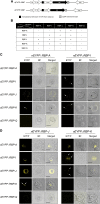Multiple RNA binding protein complexes interact with the rice prolamine RNA cis-localization zipcode sequences
- PMID: 24488967
- PMCID: PMC3938619
- DOI: 10.1104/pp.113.234187
Multiple RNA binding protein complexes interact with the rice prolamine RNA cis-localization zipcode sequences
Abstract
RNAs for the storage proteins, glutelins and prolamines, contain zipcode sequences, which target them to specific subdomains of the cortical endoplasmic reticulum in developing rice (Oryza sativa) seeds. Fifteen RNA binding proteins (RBPs) specifically bind to the prolamine zipcode sequences and are likely to play an important role in the transport and localization of this storage protein RNA. To understand the underlying basis for the binding of multiple protein species to the prolamine zipcode sequences, the relationship of five of these RBPs, RBP-A, RBP-I, RBP-J, RBP-K, and RBP-Q, were studied. These five RBPs, which belong to the heterogeneous nuclear ribonucleoprotein class, bind specifically to the 5' coding regions as well as to the 3' untranslated region zipcode RNAs but not to a control RNA sequence. Coimmunoprecipitation-immunoblot analyses in the presence or absence of ribonuclease showed that these five RBPs are assembled into three multiprotein complexes to form at least two zipcode RNA-protein assemblies. One cytoplasmic-localized zipcode assembly contained two multiprotein complexes sharing a common core consisting of RBP-J and RBP-K and either RBP-A (A-J-K) or RBP-I (I-J-K). A second zipcode assembly of possibly nuclear origin consists of a multiprotein complex containing RBP-Q and modified forms of the other protein complexes. These results suggest that prolamine RNA transport is initiated in the nucleus to form a zipcode-protein assembly, which is remodeled in the cytoplasm to target the RNA to its proper location on the cortical endoplasmic reticulum.
Figures








Similar articles
-
Characterization of RNA binding protein RBP-P reveals a possible role in rice glutelin gene expression and RNA localization.Plant Mol Biol. 2014 Jul;85(4-5):381-94. doi: 10.1007/s11103-014-0191-z. Epub 2014 Mar 30. Plant Mol Biol. 2014. PMID: 24682961
-
Isolation and identification of cytoskeleton-associated prolamine mRNA binding proteins from developing rice seeds.Planta. 2010 May;231(6):1261-76. doi: 10.1007/s00425-010-1125-x. Epub 2010 Mar 9. Planta. 2010. PMID: 20217123
-
Targeted Endoplasmic Reticulum Localization of Storage Protein mRNAs Requires the RNA-Binding Protein RBP-L.Plant Physiol. 2019 Mar;179(3):1111-1131. doi: 10.1104/pp.18.01434. Epub 2019 Jan 18. Plant Physiol. 2019. PMID: 30659066 Free PMC article.
-
The rice storage protein mRNAs as a model system for RNA localization in higher plants.Plant Sci. 2019 Jul;284:203-211. doi: 10.1016/j.plantsci.2019.04.014. Epub 2019 Apr 17. Plant Sci. 2019. PMID: 31084873 Review.
-
The Landscape of RNA-Protein Interactions in Plants: Approaches and Current Status.Int J Mol Sci. 2021 Mar 11;22(6):2845. doi: 10.3390/ijms22062845. Int J Mol Sci. 2021. PMID: 33799602 Free PMC article. Review.
Cited by
-
RNA-Binding Protein RBP-P Is Required for Glutelin and Prolamine mRNA Localization in Rice Endosperm Cells.Plant Cell. 2018 Oct;30(10):2529-2552. doi: 10.1105/tpc.18.00321. Epub 2018 Sep 6. Plant Cell. 2018. PMID: 30190374 Free PMC article.
-
mRNA Localization in Plant Cells.Plant Physiol. 2020 Jan;182(1):97-109. doi: 10.1104/pp.19.00972. Epub 2019 Oct 14. Plant Physiol. 2020. PMID: 31611420 Free PMC article. Review.
-
Characterization of RNA binding protein RBP-P reveals a possible role in rice glutelin gene expression and RNA localization.Plant Mol Biol. 2014 Jul;85(4-5):381-94. doi: 10.1007/s11103-014-0191-z. Epub 2014 Mar 30. Plant Mol Biol. 2014. PMID: 24682961
-
Multifunctional RNA Binding Protein OsTudor-SN in Storage Protein mRNA Transport and Localization.Plant Physiol. 2017 Dec;175(4):1608-1623. doi: 10.1104/pp.17.01388. Epub 2017 Oct 30. Plant Physiol. 2017. PMID: 29084903 Free PMC article.
-
RNA binding proteins (RBPs) on genetic stability and diseases.Glob Med Genet. 2024 Nov 30;12(1):100032. doi: 10.1016/j.gmg.2024.100032. eCollection 2025 Mar. Glob Med Genet. 2024. PMID: 39925443 Free PMC article. Review.
References
-
- Arn EA, Cha BJ, Theurkauf WE, Macdonald PM. (2003) Recognition of a bicoid mRNA localization signal by a protein complex containing Swallow, Nod, and RNA binding proteins. Dev Cell 4: 41–51 - PubMed
-
- Choi SB, Wang C, Muench DG, Ozawa K, Franceschi VR, Wu Y, Okita TW. (2000) Messenger RNA targeting of rice seed storage proteins to specific ER subdomains. Nature 407: 765–767 - PubMed
-
- Crofts AJ, Crofts N, Whitelegge JP, Okita TW. (2010) Isolation and identification of cytoskeleton-associated prolamine mRNA binding proteins from developing rice seeds. Planta 231: 1261–1276 - PubMed
Publication types
MeSH terms
Substances
LinkOut - more resources
Full Text Sources
Other Literature Sources

